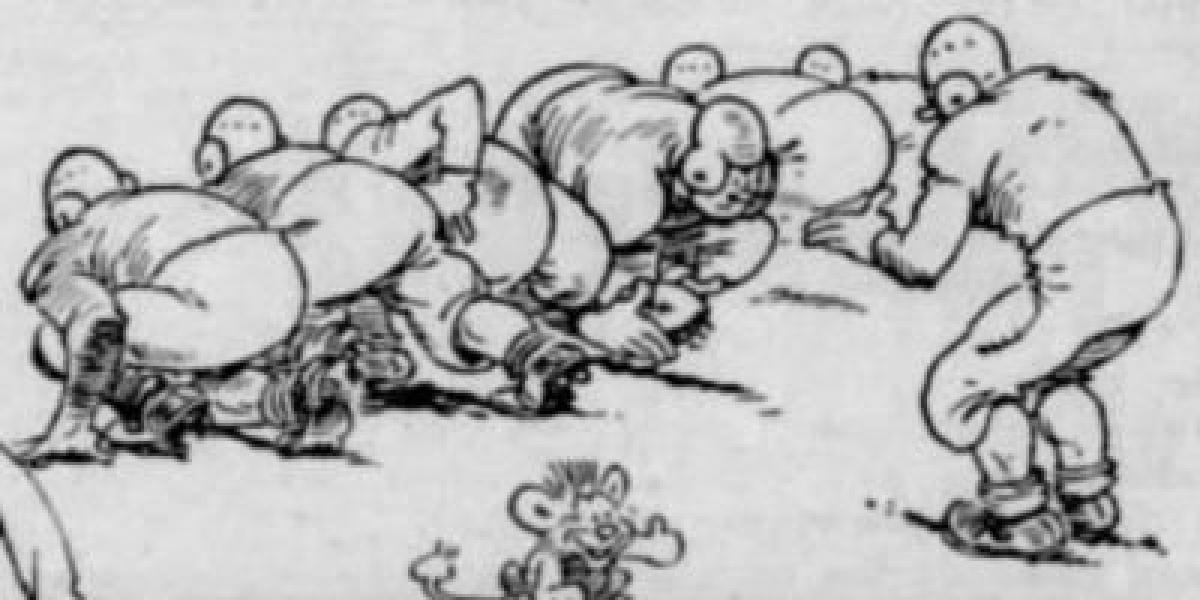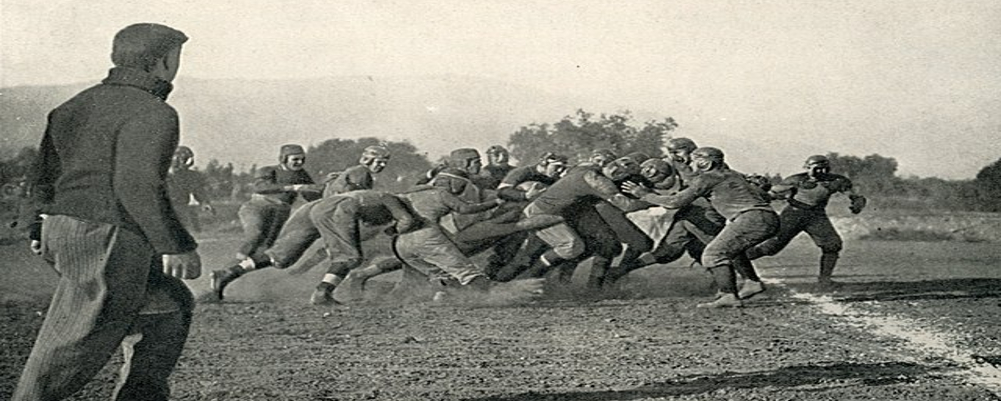Timothy Brown had a great piece awhile back in his tidbits titled: Innovation or Oddity? The Reverse Center
Reverse Center With Timothy Brown
Hello, my football friends. This is Darren Hayes of PigskinDispatch.com. Welcome once again to The Pig Pen, your portal to positive football history. And we have a Tuesday.
And once again, we are going to go down the road of football archaeology with Timothy P. Brown of that website. Tim Brown, welcome back to The Pig Pen. Hey, Darren.
Thanks for having me back. Look forward to having a little chat. Yeah, I think it's going to be a pretty interesting chat.
And this is probably going to be one where folks are going to want to go to your website, footballarchaeology.com, and go to your tidbit from September 27th of 2022. And because there's a very interesting picture that's sort of the forefront of this discussion tonight, and that's on the reverse center. Yeah, well, so here's one thing about this reverse center: it's, you know, football coaches, just like, you know, any business, probably.
They're always looking for something new. They're always trying to find a way to, you know, just improve their process, do something more efficiently, or just trick somebody. And so, you know, one of the things that has been kind of a dynamic in football forever is the difference between, you know, an innovation or an oddity or exploiting a loophole, right? So when somebody does something new and, you know, almost no matter what it is in the game, if it fits within the rules, OK, then, you know, the football world adapts by either saying, hey, that's a great idea.
We're going to start doing it, too. And, you know, others take it on, or they look at it and go, no, that's not the way we're supposed to play this game. And then they they ban it.
They change the rules and get rid of it. So, you know, any time something new comes up, you don't know which one it's going to be. Right.
So you have stuff like huddling, which was new in the 20s. People didn't know before that, you know, a couple here and there to platoon football, icing the kicker, calling plays from the sideline. All those things were not part of the game at various points in time.
But, you know, somebody came up with a cool idea, and, you know, others bought into it. But you also have things like Bo Schembechler, whose Michigan teams kept getting beat in big games that were played on grass. So he decided he was going to. He had their equipment; people put washers on the bottoms of shoes because the rules said you couldn't have, you know, spikes longer than a half inch.
So he had him put washers on and then screw the spikes in so that they extended further. But they still were only half-inch spikes. Right.
So then the next year, you know, the rule makers got up and changed the rule. It said, you know, you can't. Your spikes can't, you know, be the end of the spike, which can't be more than half an inch from the bottom of the shoe. Right.
To get away, you know, to stop people like Bo from doing things like that. Anyway, you know, I've had a couple of different topics in the articles on the site. For example, we're going to talk about reverse center tonight. But, you know, I've done one in the past on the reverse quarterback, the tower play, the 12th man on the field, you know, who was a coach rather than a play.
It was a student coach rather than a player. You know, just all these kind of goofy little ideas. But so the reverse center, just to describe it to the listener, was, you know, if you just think about a center who's going up to snap the ball, just like normally approaches the line and, you know, facing the defense.
Well, that's the norm. But in the reverse center, the center turns around. And instead of facing the defense, he's facing he's facing his backfield.
And then he squats down, reaches between his legs. And grabs the ball. And then he snaps it double underhanded.
Right. And so, you know, you kind of go, well, that's stupid. But, you know, it first came up in, like, 1912.
And then, you know, mostly what I wrote about was 1941 when when Syracuse implemented the system and his the coaches thinking and it was, you know, Ozzie Solem, he he he wanted to be able to pitch the ball or snap the ball to running backs who were further spread out. He also used what he called the Y formation. So there was a quarterback immediately behind the center.
There was another, like a fullback type, immediately behind him. And then the two halfbacks were behind the tackle. So they were, you know, a little further spread.
And so by snapping in the reverse center mode, the center could swing his arms to the right or to the left and get it to a halfback who, you know, at the snap was already heading, you know, you know, starting to sweep. So just, you know, it enabled them to sweep to send the ball in a wider arc. But he could also just put it, you know, give it right back to the quarterback.
And then they thought at the time that the center facing away from the defense also gave the center the ability to pull, you know, more quickly. And so the funny, well, one of the interesting things about it is the line coach at Syracuse that year was a guy named Bud Wilkinson, who became a pretty famous, successful football coach. You know, so anyways, he had, you know, two pretty good football minds working on this thing.
And, you know, they came up with this tactic, the reverse center. So, you know, there was some contention about its legality early on in 1941. But, you know, then some folks on the football committee said, hey, it works.
It's it's within the rules. Nothing wrong with it. We may not like it, but, you know, here it is.
Syracuse had a pretty successful season. They upset they weren't, you know, they went to Wisconsin and beat them when they weren't expected to. I think they ended up like six and three, you know, something like that.
However, at the end of the year, the football gods decided that by the time they met in early January of 42, they had Pearl Harbor that occurred. And so they basically, you know, we're going to make virtually no changes in the football rules kind of for the duration. And we will adjust some things here and there.
One of their adjustments was they require they they modified the rule to say that the seven men on the line of scrimmage have to be facing their opponent. And so with that, the reverse center. Died never to be seen again.
You know, I'm sitting here thinking about when I first saw that. You know, first I laughed and said, oh, this can't be right. And then I read your post on it. Then, I started thinking from a defensive side.
And I'm sitting here thinking, OK, you're explaining that Y formation and a good portion of the snaps are either going to the quarterback or the fullback directly behind him. Well, I'm going to put somebody, you know, in a nose guard position, a zero technique will become today. And I'm going to blow that guy up from his rear end.
And is it easy to go ahead first and blow that play up into the quarterback and fullback? So they had better be pitching to the halfbacks every time they're doing their off-tackle plays or whatever they're doing. So, yeah. Yeah.
And, you know, I can't tell you exactly how they adjusted or how they, you know, how they managed that. But they did. And, you know, it proved to be successful.
And, you know, you know, they won. They won a couple of big games doing this reverse center. But, you know, again, the football god said this isn't football the way we intended it to be.
And so so it became an oddity rather than an innovation. Well, it's interesting when you were talking about some of these innovations that people haven't seen before. I know, at least in the high school rulebook, at least from six years ago when I was still officiating, they had a rule near the beginning that was kind of a catch-all rule, which I thought was probably one of the most brilliant things they put in a rulebook.
It said that if anything happens, that is not explained in this rulebook, it's at the referee's discretion to make a decision in the fairness of, you know, football, a fair and level playing field, which, you know, not exactly in those words, I forget how they are, but that's basically the gist of it. And I read that, you know, I remember as a young official coming on. I'm like, OK, where there's so much stuff in here.
Where are the people going to come up with stuff that that's not in the rulebook? Well, when I ended up getting a white hat, it seemed to happen quite often. And one thing that comes to mind, at least in our area, is that quarterbacks at the high school level were starting to go more and more in shotgun and spread formations. So they had what was called, you know, the foot kick or the stomp start, you know, to kick a man in motion where you see it's we don't even blink at it today because it happens all the time in the pro level where, you know, quarterbacks back there in shotgun, he kicks his foot, and the guy goes in motion.
Well, back when they were first doing that, there was a big discussion. I know in officiating circles, hey, is this a false start? Should this be considered a false start, or is this, you know, part of it? A false start is anything that simulates action at the snap, and the ball's not snapped. That's the basic definition of a false start.
So this is an odd occurrence. And but he's not really simulating action to snap. So there's a lot of discussion there.
And there were some inconsistencies in particular. One team we had in our area, from crew to crew, from referee to referee, how they were handling that. And we had to get our heads together real quick and decide what we were doing.
But yeah, just some things like that that happened. And, you know, the reverse center was probably something like that. Well, and that's one of the things when huddling first came in, you know, it was just like you're saying, there were some referees that said no.
You know, this is stalling and therefore we're going to penalize you. That was a it was a two yard penalty at the time. But but they, you know, they penalized him.
And others said, no, this is perfectly fine. As long as you get the ball, you know, snapped in a reasonable time, then we're good. So, you know, they had that same kind of discussion.
But just because it was new, you know. But, you know, that whole issue of the referee having that discretion is one of the. I remember, you know, coming across it, that is at least part of the conversation when, you know, there's been a couple of times where some guy's running down the field out ahead of everybody, and a fan or a player comes out on the field and tackles.
Right. And so then, what do you do? Is it that you award the touchdown? Do you do you give them the ball at that spot? You know, and so those kinds of just bizarre situations. They are one of the reasons that they've empowered the referee as they did.
And they should. Yeah, it's as an official, I learned, though, because those are judgment calls like what you just described, the kickstart, you know, things like that. The reverse center.
That's a judgment in whoever's officiating its view if that's legal or not. And giving a fair or unfair advantage to one team over another. And, you know, that's when you would call a foul.
But judgment is the toughest thing to call a judgment call because that's something where half of the people in the stands are going to like it, and half of them are not going to like it. At the same time, we have things that are cut and dried, like an offside or a false start or, you know, things like that. Those are just plain fouls.
It's, you know, it's penalized. There's there's usually no question about it. It's not. There's no judgment in it at all.
So, yeah. Yeah. So, yeah.
Interesting. It's always interesting to get the kind of viewpoint of a referee, right? Because there are not that many. You know, there are a lot more people who've played the game and watched a lot of football out there.
Wearing a zebra shirt. Yeah. Well, they're always looking everywhere for officials.
So if somebody is interested, you'll contact your local high school chapter or, you know, your local school athletic directors, and they can for sure get you into a game of officiating because it's a great way to look at the game and you learn a lot of the game and see some things from the other side, so to speak. So it's very interesting, at least from a rule's take. So, Tim, why don't you take the time right now to share with listeners where they can find your tidbits and how they can get them in their email inbox or their Twitter each and every day? Yeah.
So, number one, if you just, you know, if you want to check out some of the articles and the things that I write about, just go to FootballArcheology.com and, you know, all the archives and everything's available on there. You know, I release it today's tidbit every day. And so if you want to make sure you get it every day, subscribe and you'll get an email with the content sent to you.
You know, that's seven o'clock Eastern every evening. And then you can also, you know, I post everything on Twitter as well. So, you know, I'm Football Archeology on Twitter.
So find me there if that's the way you'd prefer to consume. But you might miss some stories that way. So that's the problem.
That's the danger. Yeah, you don't want to do that. Don't want to subscribe.
It's easy. It's very painless. So, Tim, thank you very much.
Keep up the great work of preserving football history and enlightening us on some of these great antiquities of the game. And because we sure enjoy them and love to talk to you about them. And we love to talk to you again next week.
Very good. As always, thank you again, sir.
Transcribed by TurboScribe.ai.




